2025.05.26
- Features
-
Services/ProductsServices/ProductsServices/Products

Learn more about the retail trading conditions, platforms, and products available for trading that FXON offers as a currency broker.
You can't start without it.
Trading Platforms Trading Platforms Trading Platforms
Features and functionality comparison of MetaTrader 4/5, and correspondence table of each function by OS
Two account types to choose
Trading Account Types Trading Account Types Trading Account Types
Introducing FXON's Standard and Elite accounts.
close close

-
SupportSupportSupport

Support information for customers, including how to open an account, how to use the trading tools, and a collection of QAs from the help desk.
Recommended for beginner!
Account Opening Account Opening Account Opening
Detailed explanation of everything from how to open a real account to the deposit process.
MetaTrader4/5 User Guide MetaTrader4/5 User Guide MetaTrader4/5 User Guide
The most detailed explanation of how to install and operate MetaTrader anywhere.
FAQ FAQ FAQ
Do you have a question? All the answers are here.
Coming Soon
Glossary Glossary GlossaryGlossary of terms related to trading and investing in general, including FX, virtual currencies and CFDs.
News News News
Company and License Company and License Company and License
Sitemap Sitemap Sitemap
Contact Us Contact Us Contact Us
General, personal information and privacy inquiries.
close close

- Promotion
- Trader's Market
- Partner
-
close close
Learn more about the retail trading conditions, platforms, and products available for trading that FXON offers as a currency broker.
You can't start without it.
Features and functionality comparison of MetaTrader 4/5, and correspondence table of each function by OS
Two account types to choose
Introducing FXON's Standard and Elite accounts.
Support information for customers, including how to open an account, how to use the trading tools, and a collection of QAs from the help desk.
Recommended for beginner!
Detailed explanation of everything from how to open a real account to the deposit process.
The most detailed explanation of how to install and operate MetaTrader anywhere.
Do you have a question? All the answers are here.
Coming Soon
Glossary of terms related to trading and investing in general, including FX, virtual currencies and CFDs.
General, personal information and privacy inquiries.
Useful information for trading and market information is posted here. You can also view trader-to-trader trading performance portfolios.
Find a trading buddy!
Share trading results among traders. Share operational results and trading methods.
- Legal Documents TOP
- Client Agreement
- Risk Disclosure and Warning Notice
- Order and Execution Policy
- Complaints Procedure Policy
- AML/CFT and KYC Policy
- Privacy Policy
- eKYC Usage Policy
- Cookies Policy
- Website Access and Usage Policy
- Introducer Agreement
- Business Partner Agreement
- VPS Service Terms and Condition

This article was :
published
updated
Weekly FX Market Review and Key Points for the Week Ahead
In the foreign exchange market for the week that ended on May 25th, the dollar continued to weaken against major currencies due to the downgrade of the U.S. credit rating and a series of news about tariffs between the U.S. and China, as well as the U.S. and Europe. The USDJPY fell throughout the week, with a temporary rebound, to close the weekly trading session in the middle of the 142 yen range.
May 19 (Mon)
Following Moody's downgrade of the U.S. credit rating at the end of the previous week, the USDJPY started the weekly trading session with a downward gap. After falling to the 145.2 yen range, the pair struggled to gain further upside and hovered around the 145 yen level. Meanwhile, the EURUSD and GBPUSD remained firm, rising to 1.127 and 1.34, respectively.
May 20 (Tue)
The USDJPY rose to 145.51 yen in earlier Tokyo time as this day fell on "Gotobi", when many settlements are made in Japan. However, the pair subsequently fell back to the 144.0 yen range and remained weak throughout the day. At the closely watched bilateral meeting between U.S. and Japanese finance ministers, they did not discuss exchange rates specifically, which contributed to the dollar sell-off.
The weakening dollar helped the EURUSD rise to the 1.128 range after some volatile fluctuation, and the GBPUSD climbed to the 1.339 range.
May 21 (Wed)
As the dollar continued to weaken, traders took a risk-off stance to buy the yen following reports that Israel was planning to attack Iran's nuclear facilities. The USDJPY broke below the 144 yen level and touched 143.2 yen during trading hours. Meanwhile, the EURUSD rose to the 1.136 range, and the GBPUSD climbed to reach the 1.34 range.
May 22 (Thu)
At the bilateral meeting, the U.S. and Japanese financial ministers did not discuss specific exchange rates. In response to this news, traders sold the yen. The USDJPY rose sharply to the 144.40 yen range in the early Tokyo trading hours. During the New York trading hours, the pair fell back, but then rebounded to the 144.3 yen range.
The buyback of the dollar pushed the EURUSD down to the 1.125 range during the trading hours. The GBPUSD hovered in the lower 1.34 range.
May 23 (Fri)
The sell-off of the dollar against major currencies continued as concerns over the U.S. fiscal deficit persisted. On top of that, the dollar weakened further against the yen following reports that President Donald Trump would impose tariffs of at least 25% on iPhones not manufactured in the U.S. The USDJPY plummeted to the middle of the 142 yen range.
Meanwhile, the EURUSD rose to the 1.137 range during trading hours, and the GBPUSD remained firm above the 1.35 level.
Economic Indicators and Statements to Watch this Week
(All times are in GMT)
May 28 (Wed)
- 18:00 U.S.: Federal Reserve Open Market Committee (FOMC) meeting minutes
May 29 (Thu)
- 12:30 U.S.: January-March quarterly Gross Domestic Product (revised GDP)
May 30 (Fri)
- 12:30 U.S.: April personal consumption expenditures (PCE deflator)
- 12:30 U.S.: April personal consumption expenditures (PCE core deflator, excluding food and energy)
This Week's Forecast
The following currency pair charts are analyzed using an overlay of the ±1σ and ±2σ standard deviation Bollinger Bands, with a 20-period moving average.
USDJPY
As the Trump tariffs and the situation in the Middle East heighten the risk-off atmosphere, traders will continue to buy the yen and sell the dollar. Unless new dollar-buying factors emerge, the USDJPY could fall to around the 140 yen level.
Next is an analysis of the USDJPY daily chart.
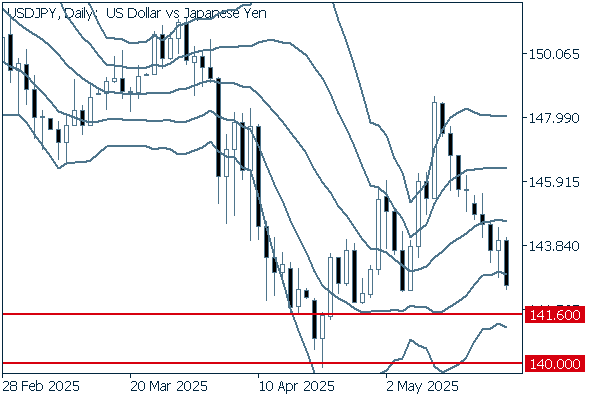

Since hitting the 148 yen range in early May, the pair has been declining. It closed last week's trading session below -1σ. The current support line lies around the 141.60 yen level. If the pair falls below this level, it will most likely test the 140 yen range.
We continue with an analysis of the USDJPY weekly chart.
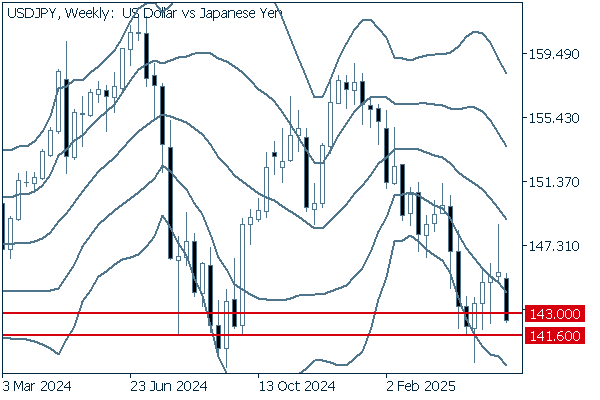

The weekly chart shows that traders sold the dollar on the rally. The pair broke below the 143 yen level and crossed below -1σ to close last week's trading session, strengthening the downtrend. The pair will likely continue to fall toward the 140 yen level.
EURUSD
The EURUSD had fallen since early May. Now that the downtrend has halted, the pair is entering an uptrend. If the dollar continues to weaken, the pair will likely rise toward the high set in April.
Next is an analysis of the EURUSD daily chart.
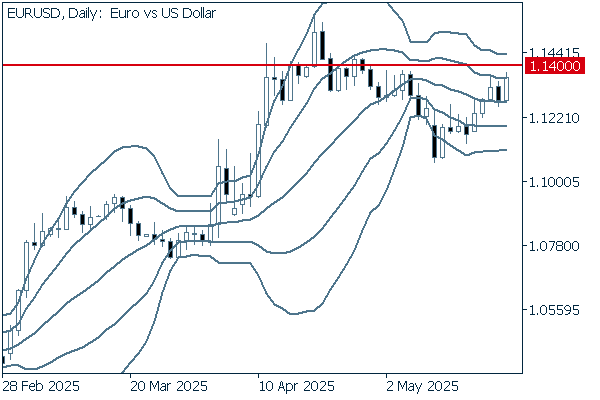

Last week, the EURUSD broke above the middle line and reached +1σ. Since then, the pair has been moving sideways. The current resistance line lies around the 1.14 level. If the pair breaks above this level, it will likely rise further.
We continue with an analysis of the EURUSD weekly chart.
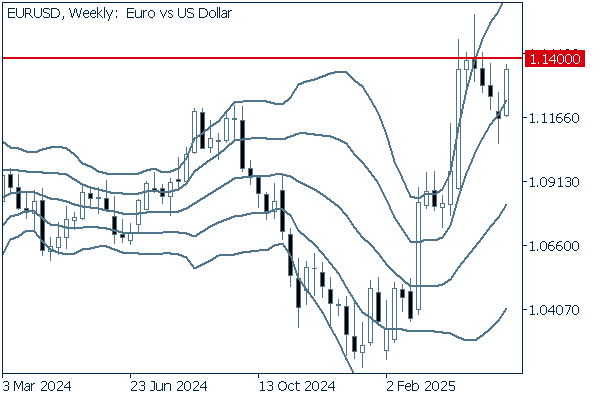

The pair was pushed back within the band after breaking above +2σ, and then continued to fall. However, the pair showed a rebound last week. If the pair breaks above the 1.14 level, it will likely continue rising.
GBPUSD
The downgrade of the U.S. credit rating and Trump's policy of imposing high tariffs on iPhones have accelerated the sell-off of the dollar. Consequently, traders are opting to purchase the pound, which surpassed its year-to-date and 2024 highs. The behavior of the weakening dollar will continue to dominate the market.
Now, we analyze the daily GBPUSD chart.
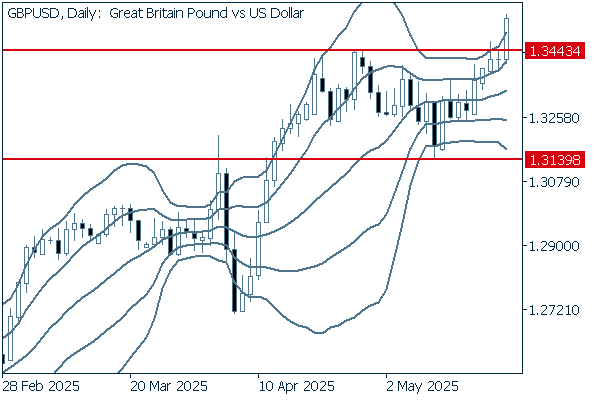

The pair rebounded into the band after touching -2σ. Since then, it has maintained upward momentum, even breaking through the 2024 high of 1.3443. While the upward trend is strong, it's important to note that this momentum may slow down due to profit-taking. However, as long as the pair remains above 1.3139, it will maintain its current momentum as traders will likely look for buying opportunities during dips.
We continue with an analysis of the GBPUSD weekly chart.
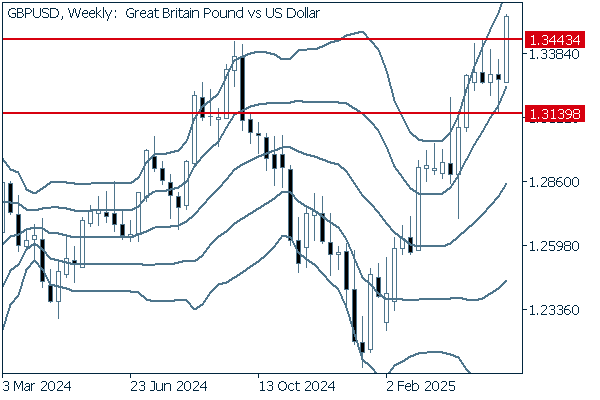

On the weekly chart, the pair broke above the 2024 high after a four-week period of range-bound fluctuation. The pair may temporarily decline due to profit-taking. However, it is safe to say that, as long as the pair remains above 1.3139, the uptrend will likely continue.
Don't miss trade opportunities with a 99.9% execution rate
Was this article helpful?
0 out of 0 people found this article helpful.
Thank you for your feedback.
FXON uses cookies to enhance the functionality of the website and your experience on it. This website may also use cookies from third parties (advertisers, log analyzers, etc.) for the purpose of tracking your activities. Cookie Policy
